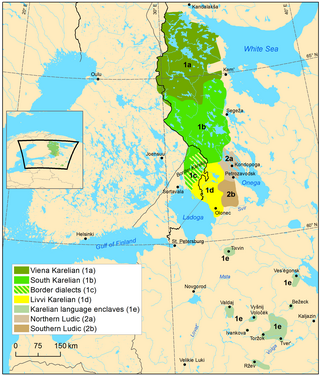
Finno-Ugric is a traditional grouping of all languages in the Uralic language family except the Samoyedic languages. Its formerly commonly accepted status as a subfamily of Uralic is based on criteria formulated in the 19th century and is criticized by some contemporary linguists such as Tapani Salminen and Ante Aikio. The three most spoken Uralic languages, Hungarian, Finnish, and Estonian, are all included in Finno-Ugric.

The Uralic languages form a language family of 42 languages spoken predominantly in Europe and North Asia. The Uralic languages with the most native speakers are Hungarian, Finnish, and Estonian. Other languages with speakers above 100,000 are Erzya, Moksha, Mari, Udmurt and Komi spoken in the European parts of the Russian Federation. Still smaller minority languages are Sámi languages of the northern Fennoscandia; other members of the Finnic languages, ranging from Livonian in northern Latvia to Karelian in northwesternmost Russia; and the Samoyedic languages, Mansi and Khanty spoken in Western Siberia.

Karelian is a Finnic language spoken mainly in the Russian Republic of Karelia. Linguistically, Karelian is closely related to the Finnish dialects spoken in eastern Finland, and some Finnish linguists have even classified Karelian as a dialect of Finnish, though in the modern day it is widely considered a separate language. Karelian is not to be confused with the Southeastern dialects of Finnish, sometimes referred to as karjalaismurteet in Finland. In the Russian 2020–2021 census, around 9,000 people spoke Karelian natively, but around 14,000 said to be able to speak the language.

The Samoyedic or Samoyed languages are spoken around the Ural Mountains, in northernmost Eurasia, by approximately 25,000 people altogether. They derive from a common ancestral language called Proto-Samoyedic, and form a branch of the Uralic languages. Having separated perhaps in the last centuries BC, they are not a diverse group of languages, and are traditionally considered to be an outgroup, branching off first from the other Uralic languages.

Ludic, or Ludian, or Ludic Karelian, is a Finnic language in the Uralic language family or a Karelian dialect. It is transitional between the Olonets Karelian language and the Veps language. It is spoken by 300 Karelians in the Republic of Karelia in Russia, near the southwestern shore of Lake Onega, including a few children.

Nenets is a pair of closely related languages spoken in northern Russia by the Nenets people. They are often treated as being two dialects of the same language, but they are very different and mutual intelligibility is low. The languages are Tundra Nenets, which has a higher number of speakers, spoken by some 30,000 to 40,000 people in an area stretching from the Kanin Peninsula to the Yenisei River, and Forest Nenets, spoken by 1,000 to 1,500 people in the area around the Agan, Pur, Lyamin and Nadym rivers.

The Finno-Samic languages are a hypothetical subgroup of the Uralic family, and are made up of 22 languages classified into either the Sami languages, which are spoken by the Sami people who inhabit the Sápmi region of northern Fennoscandia, or Finnic languages, which include the major languages Finnish and Estonian. The grouping is not universally recognized as valid.

The Mansi languages are spoken by the Mansi people in Russia along the Ob River and its tributaries, in the Khanty–Mansi Autonomous Okrug, and Sverdlovsk Oblast. Traditionally considered a single language, they constitute a branch of the Uralic languages, often considered most closely related to neighbouring Khanty and then to Hungarian.

The Finnic or Baltic Finnic languages constitute a branch of the Uralic language family spoken around the Baltic Sea by the Baltic Finnic peoples. There are around 7 million speakers, who live mainly in Finland and Estonia.

The Ob-Ugric languages are a commonly proposed branch of the Uralic languages, grouping together the Khanty (Ostyak) and Mansi (Vogul) languages. Both languages are split in numerous and highly divergent dialects. They, along with Hungarian, are often thought to comprise the Ugric branch of the Uralic languages, though the acceptance of Ugric is less frequent than acceptance of Ob-Ugric.

En with hook is a letter of the Cyrillic script. Its form is derived from the Cyrillic letter En (Н н) by adding a hook to the right leg.

A chum is a temporary dwelling used by the nomadic Uralic reindeer herders of northwestern Siberia of Russia. The Evenks, Tungusic peoples living in Russia, Mongolia and China also use chums, as do the Yeniseian-speaking Ket people. They are also used by the southernmost reindeer herders, of the Todzha region of the Republic of Tyva and their cross-border relatives in northern Mongolia. It has a design similar to a Native American tipi but some versions are less vertical. It is very closely related to the Sami lavvu in construction, but is somewhat larger in size. Some chums can be up to thirty feet in diameter.
Elements of a Proto-Uralic religion can be recovered from reconstructions of the Proto-Uralic language.

The Baltic Finnic peoples, often simply referred to as the Finnic peoples, are the peoples inhabiting the Baltic Sea region in Northern and Eastern Europe who speak Finnic languages. They include the Finns, Estonians, Karelians, Veps, Izhorians, Votes, and Livonians. In some cases the Kvens, Ingrians, Tornedalians and speakers of Meänkieli are considered separate from the Finns.
The Intercontinental Dictionary Series is a large database of topical vocabulary lists in various world languages. The general editor of the database is Bernard Comrie of the Max Planck Institute for Evolutionary Anthropology, Leipzig. Mary Ritchie Key of the University of California, Irvine is the founding editor. The database has an especially large selection of indigenous South American languages and Northeast Caucasian languages.

Indigenous peoples of the Subarctic are the aboriginal peoples who live in the Subarctic regions of the Americas, Asia and Europe, located south of the true Arctic at about 50°N to 70°N latitude. This region includes the interior of Alaska, the Western Subarctic or western Canadian Shield and Mackenzie River drainage area, the Eastern Subarctic or Eastern Canadian Shield, and most of Fennoscandia, Northwestern Russia and Siberia. Peoples of subarctic Siberia and Greenland are included in the subarctic; however, Greenlandic Inuit are usually classified as Indigenous peoples of the Arctic.
Proto-Finnic or Proto-Baltic-Finnic is the common ancestor of the Finnic languages, which include the national languages Finnish and Estonian. Proto-Finnic is not attested in any texts, but has been reconstructed by linguists. Proto-Finnic is itself descended ultimately from Proto-Uralic.
The various regional and minority languages in Europe encompass four categories:




















